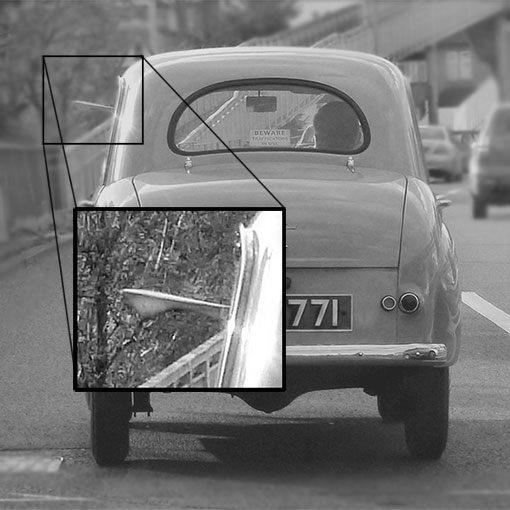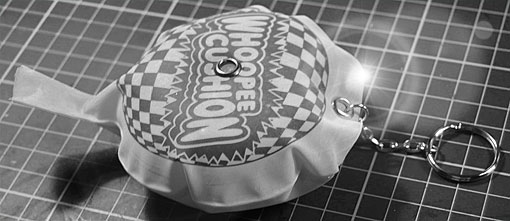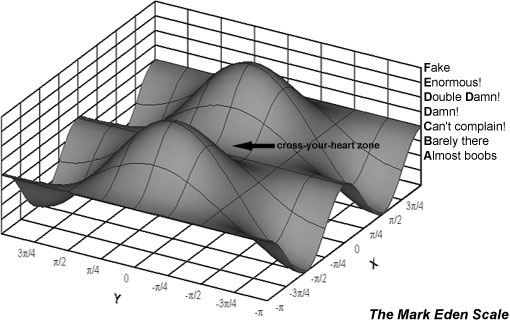Saw this today. Went *SQUEE*

Well, this isn’t the one I saw. I nicked this picture off the Wikipedia article, which is curiously vague about whether they were ever used in US cars. I’ve never seen one, even in the movies, but Uncle B thinks they must’ve.
It’s called a trafficator. It’s an old fashioned turn signal. It’s a little semaphore dingus that pops out the side of the car and lights up. It’s adorable.
I’ve seen semiphore-style traffic signals in cartoons — placards that pop out the side of a pole — though I’ve never seen one in real life. But never seen a trafficator. You?
Oh, btw, we’re going to London for the day tomorrow. I’ll post if we’re back in time. If not — have a good weekend!
September 25, 2014 — 9:42 pm
Comments: 25
The March of Science

I realize most people don’t come to sweasel.com for the latest breakthroughs in science and technology, but sometimes a generalist blogger is lucky enough to find herself perfectly positioned to break a story the specialists blogs have missed.

Such a lucky find is the self-inflating miniature whoopee cushion.
How is this possible? In my lifetime? you ask. The secret is a light polyester sponge inside the cushion.
To operate, place your thumb over the grommet and squeeze, making the expected poo, poo sound. When the cushion is subsequently released, the sponge expands, pulling air in through the vent hole and refilling the item for immediate use.
Whatever little yellow genius at the Ho Lee Fuk Toy and Novelty Company of Shanghai came up with that one, I owe him a beer.

Have a good weekend, everyone. And remember — adult supervision is required. I don’t know what kind of dimwitted rug monkeys y’all are breeding out there, but I bet one of them could put out an eye with a whoopee cushion.
May 7, 2010 — 9:47 pm
Comments: 36
DPlot thickens

You know how I was bitching in my last post about no longer owning any graphing software? Well, a very nice bloke took notice (he has a Google Alerts set for “graphing software”) and offered me a free license to his graphing software program DPlot.
It’s my policy never to say no to free stuff. It’s my policy now, anyway — I didn’t have to have a policy before, since nobody ever offered me any free stuff. So I downloaded DPlot, followed the simple installation instructions, and in no time at all, I was feeling severely mentally retarded.
Seriously, it’s all math and shit. I know some of you are actual engineers and science type peeps, so you should probably mosey over and check it out. I mean, he’s an awfully nice guy and he’s got testimonials from other nerds saying how great his program is. I know you poindexters don’t dare lie to each other, on account of your huge brains, so it’s probably pretty good at whatever the hell it does.
Look! I made boobies!
January 14, 2010 — 6:30 pm
Comments: 24
Risk assessment, weasel style

Rick Rostrom commented on the last post that Al Gore’s statement about the relationship between reason and fear — while garbled as only Algore can — was based on some real research. Indeed it is.
Specifically, imaging of the brain has recently taught us that the pathways from our emotion gland to our logic lobe are much larger than the pathways leading back the other way. From this (near as I can figure it) Al deduces that it’s easier to frighten people into thinking than it is to think people into being scared.
This is why stupid people shouldn’t be allowed to handle facts (not you Rick — I know you know Al knows nuffink). Analogies about pipelines and highways and streams can only get you so far, and then they drop you over a cliff into a kettle of fish. The “size” of a neurological connection doesn’t necessarily speak to how “easy” it is for information to move. It is likely to have entirely different implications. Say, speed.
Like, I’m a hell of a lot more frightened of getting cancer (logical; there’s a lot of it in my family) than I am being crushed by a grand piano falling from a great height. But if I see a Steinway hurtling toward my head, I’m going to need to jump sideways really, really fast. And then figure out how the fuck a crane got in here, with the low ceilings and all.
I have worked with people who assess risk for engineering projects. They scoff at what they believe is the emotional, irrational way people evaluate personal risk. There’s a sort of math makes it science prejudice about sticking with pure probabilities and leaving sphincter-clenching horror out of the equation. But is that really more sciencier?
Okay, you’re like a willionty-jillion times more likely to die in a car crash than a plane crash. So why do people sweat flying in a way they don’t sweat driving? Wellll…most of us have personal experience of traffic accidents; they range from the truly fucking awful to the merely annoying. A plane wreck, on the other hand — son, you’re going to die. And before you do, you’re probably going to see it coming. Good and hard. Trapped in a small metal box. With a bunch of screaming strangers. And your pants on fire.
Yeah, I think even Spock would add that into his risk evaluation alongside pure numerical probability.
So, how likely a thing is does have to count the most. But other factors do and should count, as well. How horrible it would be. Whether you could prevent it. How predictable it is. How much warning you’re likely to have.
Have you heard the argument that terrorism should be WAY down in our list of priorities because the death count is so small? That there is some serious stupid masquerading as science. Terrorism adds human malice into the equation: a bunch of somebodies aiming all their brainal capacity at sneaking past every safeguard to do something of maximum horror, pain, visibility and surprise. I want a buttload of resources thrown at that creepy shit no matter how much more likely I am to be hit by lightning.
Emotional considerations are a kind of a logic. Thinking is not the opposite of feeling. They can elbow each other out of the way, but they aren’t two different states of the same element.
And poor old Al Gore, who thinks he can use the one to prop up the other, doesn’t have either on his side.
July 9, 2009 — 7:33 pm
Comments: 29
Steam-powered Britannia

Once and sometimes twice a year, on Hope Farm in Sellindge, Kent, Britain comes out to play. The old Britain. The steam powered one.
There are vintage cars and motorcycles and tractors and musical automatons and, older still, shire horses pulling the plough. There are people selling old screwdrivers and thumbplanes and tires (or tyres, if you prefer) and cakes and teacups and books. There was a Magic Accordeola playing Monty Python’s “Always Look on the Bright Side of Life.”
And there are steam engines. Steam tractors, steam motorcycles, steam rollers.
We ate a good Dutch cheeseburger and listened to a bad garage band. Mostly, though, we looked at, listened to, smelled the bitumenous exhalations of and otherwise enjoyed keeping company with steam engines.
It was a happy end to a happy two weeks. And then the rains came. And the weather, which had been sunny and fine the whole time, turned mizzly and cold and entirely appropriate to my mood. London tonight in the drizzle, Boston tomorrow night in the…whatever.
Oh, well. That’s tomorrow.

May 28, 2007 — 6:44 pm
Comments: 6
It doth suck and, verily, doth it blow

Today’s the day I had to show my current multimedia dingus to the client. It’s basically a little interactive thing that asks a question, stores the answer, shows a video, and gives some feedback, times ten. Easy, right?
Then the artistic genius building the kiosk decided he wants it to run vertically. Like, portrait. Computers do not do this, says I. Well — says he — I’ve never done it before, either, but I think you build it sideways and we’ll physically rotate the monitor. Oh, and no touchscreen — we’re tucking the computer out of sight and giving you three hardwired buttons. Three whole buttons. This’ll be packed with interactive functionality.
Um. Monitor #2 will rotate (I have three monitors — worship me), but you can’t design rotated. Up/down arrows become side-to-side arrows, the mouse is all over the joint. I can rotate the monitor to run the application, but I have to design it sideways and crane. Fabulous.
I had to bribe the video guys to use their +3 Video Editing mojo to rotate all my .avi files for me. My primitive video stuff doesn’t have a “make it sideways” spell. I’ve been excreting building supplies over this for a week.
So today I pitch it to the client — no, the client, the client’s boss, and the client’s boss’ boss. The latter is a woman whose name strikes fear in the hearts of cubiclemonkeys everywhere. Say it aloud and hear the gentle pitter-pat of ass-cheeks clenching. She isn’t a cruel woman. She’s that potent combination of stupid and powerful. This is cubiclemonkey kryptonite.
They gather in my office. I rotate the monitor for them, and in so doing somehow hit a button that kills the signal. It goes black. I have a feeling now is a really bad time to figure out what all those little buttons at the bottom of the monitor do. Time rubberbands while I punch buttons and sweat, though it might’ve been kinder if I hadn’t gotten it working eventually.
I love working for a research and engineering company. I love learning about geeky, science-ish things. But there’s no getting around it: engineers hate subtlety. I designed an interface of duotoned photographs: all muted blue and dusty red. Earthy variations on our corporate colors, with a nice, bangy video window in front.
“My eye goes right to the video window in the middle”
“Excellent! That’s just what I intended.”
“But I can’t really see the photos in the background that well.”
“Excellent! That’s just what I intended.”
“Change it!”
“Okey-doke!”
They discuss among themselves what color goes best with red and blue. Something nice and bright. Orange? Yellow? And then one of them leans forward says, “you know those web sites where there’s text and it’s on this sort of lozenge thing and it’s tumbling over and over — can we have one of those animations?” Something inside of me rolled over, pulled the covers over its head and cried itself to sleep.
I had originally promised them a bunch of functionality, but I presumed I had a full keyboard to work with. Now I have three buttons: “yes” “no” and “reset.”
So they’re all like, “can we skip to specific scenarios?”
And I’m like, “no. I have three buttons, and they’re totally spoken for.”
“Can we have a demo mode?”
“No, I only have three buttons.”
“Can we have a help screen?”
“I have three buttons.”
“Can we have fast forward?”
“Yes, sure, if you can fast forward with your mind.”
Thank you, Ace, for planting that dangerously insubordinate snark in my brain.
It got back to me later that they were, on the whole, pleased. I mean, I’m going to have to rape and pillage my own design, but I’ve been professionally outraging my artistic sensibilities for decades. I’m getting good at it.
And, anyhow, it’s Friday. Like I give a rat’s ass about anything on Friday.
March 30, 2007 — 10:02 am
Comments: 14
Engineer humor: no laughing matter
I like working with engineers — it’s that refreshing lack of nuance — but I don’t think I’d want to own one. In private life, Weasel is all about the gray areas.
I made a smartass remark in a meeting once about a ball valve (it had a drainage cock!) and was rewarded with a solemn exposition on the inner workings of valves. I thought the non-engineer across from me was going to ‘splode trying to hold it in.
It’s not that engineers have no sense of humor, but their humor has a certain… literalness about it. I used to joke that engineers are the reason we have to print “This Page Intentionally Left Blank” on the blank pages, or they’d be calling me up and complaining. Until the day an engineer said, “oh, engineers think that’s funny, too. Because once you print ‘This Page Intentionally Left Blank’ on it, it’s no longer blank.”
See? Engineer humor.
A very senior engineer once told me engineers are the way they are because they spend five years learning how to do the calculations, at the end of which they are given a book with all the answers in. Fucking furious. You would be, too.
I was copying files to a CD in front of an engineer once, and he looked at this animated dialog box

and said, “I love to watch this. No matter how many files it copies, that piece of paper never misses the folder.”
I think he was kidding.
March 5, 2007 — 10:38 am
Comments: 5
Engineers are from Mars, Scientists are from Venus
I want to be very, very careful when I talk about work. I need my job. I really like the firm I work for — if we had a company song, I’d sing it. Without irony or sarcasm or anything. But it’s a stuffy old corporation; I’m pretty sure that ethics agreement I sign every year means they’d rather not be associated with someone who dresses up like a weasel and says “fuck” a lot. So, you know, discretion.
Broadly speaking, my employer is a Research and Engineering firm. Working there has given me an increased respect for engineers and a somewhat diminished respect for scientists. Engineers are what I always thought scientists were supposed to be: dealers in the empirical.
Science, it turns out, is a shockingly consensus activity. Less about mining those precious nuggets of truth, more about getting the other kids to notice you. I sometimes prepare models and illustrations to support scientific papers. We joke that an illustration goes through seven rounds of revisions as it moves down the hallway, and the last reviewer changes everything back to where it was in the first place. (Oh, how we laugh!)
Peer review = peer pressure. If you liked Junior High, you’ll love science.
Here’s how an engineer goes about it. He takes an aluminum rod and attaches weights to the center until the rod bends. He makes note of the weight. He does this five times, takes the average, and calls that The Weight At Which An Aluminum Rod Will Bend.
Here’s how a scientist does it. He looks at the literature on The Weight At Which An Iron Rod Will Bend and predicts how the aluminum rod will bend based on a comparison of the tensile strength of the two metals. He then passes it to Bob who is obsessed with meta-studies. Bob wrote a special program that sifts through piles of published material on metallurgy (regardless of source or quality) and spits out conclusions. He passes the result to John. John secretly thinks Bob is a maroon, and is delighted to point out that Bob’s program lumped metric and imperial units together and Bob’s contribution will have to be thrown out. So it goes to a research assistant whose job it is to make the imperial to metric conversions before it goes back through Bob’s data sifter. Then it goes to Bill, who points out that the original Weight At Which An Iron Rod Will Bend study was seriously flawed and recommends using The Weight At Which A Steel Rod Will Bend study as a starting point instead. Back to square one. Finally, it goes to the head of the department, who blows his top because “the last time we went on record with a precise numerical metal-bending prediction, we got our asses sued off,” and shit-cans the whole thing.
See, engineers have to make actual stuff. If an engineer makes a duff calculation, the bridge falls down and lots of people die. He might even get fired. When a scientist turns out to be wrong, it’s all part of the rich interplay of ideas that is woven into the very fabric of scientific investigation and shit. No scientist ever got famous dreaming up boring theories, so the temptation is to pull something big and interesting out of your ass and throw it against the wall. The career consequences of being wrong are minor.
I’m generalizing grossly, of course. And if I can generalize more grossly still, judging from snippets of conversation I hear walking through the company cafeteria, engineers lean rightward politically, scientists leftward.
I think of this whenever I read that “scientists say” something. Particularly when that something is big and interesting and looks like it was pulled out of an ass.
Get back to me when engineers start saying it.
— 7:53 am
Comments: 2











